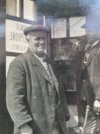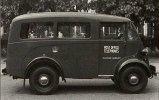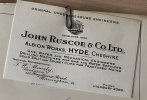-
Welcome to this forum . We are a worldwide group with a common interest in Birmingham and its history. While here, please follow a few simple rules. We ask that you respect other members, thank those who have helped you and please keep your contributions on-topic with the thread.
We do hope you enjoy your visit. BHF Admin Team
You are using an out of date browser. It may not display this or other websites correctly.
You should upgrade or use an alternative browser.
You should upgrade or use an alternative browser.
Telephone history: Telephone Service in Birmingham
- Thread starter Aidan
- Start date
Richard Dye
master brummie
Just slightly ahead of its time!“The full title of this version was 'Area Planning and General Purpose Vehicle, Type 1 (Morris).”
The J-type van : a classic light commercial, by Pitcher, Harvey (2002)
View attachment 178655
My maternal grandfather, John Chinn, was gardener in a private house in Edgbaston, but his employer became a manager of the National Telephone Co. and decided he no longer required a gardener. He got his old gardener a job up the poles and down the holes as a labourer. But at 46 the work was increasingly physically demanding. He much preferred gardening. A sunny day with his mate. [Employed from 1911 census - he died in 1932]


Last edited:
cookie273uk
Gone but not forgotten
When I was a PO Telephone engineer (1956 to 87) I drove a Morris 'Z' type van (I think it only had 3 gears ?) then a Morris Minor, my favourite followed by another Morris but I cannot think what it was. Eric
mw0njm.
A Brummie Dude
mw0njm.
A Brummie Dude
Eric Gibson
master brummie
Those Z vans at the post office had rubber front wings...........obviously didn't think much of the driver's skills. 
solihullflyer
Brummie babby
I worked in Anchor repeater station from 1967 to 1980 when I moved to the RHQ. During the day there was anything from 50 to 100 people down there working in the repeater station, exchange, trunk test, construction and power. After about 17:00 there was about 6 overnight, at weekends and Bank Holidays.
At one end of the tunnels you could hear the noise from the construction of the Queensway tunnels and very occasionally you could hear someone walking over the roof!!! That being many feet of concrete and even move of sandstone as we were some 100 feet down under Telephone House. There were several construction workers killed during the digging out and construction which led to stories of ghosts. Some people wouldn't go into certain areas unaccompanied.
To get into Anchor you either had to go through Central Exchange or go up to one of the higher floors and walk though then descend to the basement and out the back and then through a small doorway. Normally you had a lift to get down but when it broke we had to descend/climb a series of near vertical ladders with small landings in between each section. I seem to remember that the emergency exit at the far end of the central tunnel had 144 steps to get out.
I remember one weekend we were having our sandwiches and we smelt smoke. We tracked it down to a new shaft that was being constructed to Fleet St so two of us climbed the ladders up the shaft and on reaching street level we opened the access and found some firemen extinguishing a fire in the builders huts. They were quite surprised to see us appearing out of the roadway. We said our hellos and went back down to finish lunch.
At one end of the tunnels you could hear the noise from the construction of the Queensway tunnels and very occasionally you could hear someone walking over the roof!!! That being many feet of concrete and even move of sandstone as we were some 100 feet down under Telephone House. There were several construction workers killed during the digging out and construction which led to stories of ghosts. Some people wouldn't go into certain areas unaccompanied.
To get into Anchor you either had to go through Central Exchange or go up to one of the higher floors and walk though then descend to the basement and out the back and then through a small doorway. Normally you had a lift to get down but when it broke we had to descend/climb a series of near vertical ladders with small landings in between each section. I seem to remember that the emergency exit at the far end of the central tunnel had 144 steps to get out.
I remember one weekend we were having our sandwiches and we smelt smoke. We tracked it down to a new shaft that was being constructed to Fleet St so two of us climbed the ladders up the shaft and on reaching street level we opened the access and found some firemen extinguishing a fire in the builders huts. They were quite surprised to see us appearing out of the roadway. We said our hellos and went back down to finish lunch.
Thank you for your firsthand account. For those who don't know this link is instructive - but I have no way of knowing its accuracy. I have only been in BT Tower exchange and never Anchor. https://www.subbrit.org.uk/sites/birmingham-anchor-exchange/I worked in Anchor repeater station from 1967 to 1980 when I moved to the RHQ. During the day there was anything from 50 to 100 people down there working in the repeater station, exchange, trunk test, construction and power. After about 17:00 there was about 6 overnight, at weekends and Bank Holidays.
At one end of the tunnels you could hear the noise from the construction of the Queensway tunnels and very occasionally you could hear someone walking over the roof!!! That being many feet of concrete and even move of sandstone as we were some 100 feet down under Telephone House. There were several construction workers killed during the digging out and construction which led to stories of ghosts. Some people wouldn't go into certain areas unaccompanied.
To get into Anchor you either had to go through Central Exchange or go up to one of the higher floors and walk though then descend to the basement and out the back and then through a small doorway. Normally you had a lift to get down but when it broke we had to descend/climb a series of near vertical ladders with small landings in between each section. I seem to remember that the emergency exit at the far end of the central tunnel had 144 steps to get out.
I remember one weekend we were having our sandwiches and we smelt smoke. We tracked it down to a new shaft that was being constructed to Fleet St so two of us climbed the ladders up the shaft and on reaching street level we opened the access and found some firemen extinguishing a fire in the builders huts. They were quite surprised to see us appearing out of the roadway. We said our hellos and went back down to finish lunch.
Pedrocut
Master Barmmie
I worked in Anchor repeater station from 1967 to 1980 when I moved to the RHQ. During the day there was anything from 50 to 100 people down there working in the repeater station, exchange, trunk test, construction and power. After about 17:00 there was about 6 overnight, at weekends and Bank Holidays.
At one end of the tunnels you could hear the noise from the construction of the Queensway tunnels and very occasionally you could hear someone walking over the roof!!! That being many feet of concrete and even move of sandstone as we were some 100 feet down under Telephone House. There were several construction workers killed during the digging out and construction which led to stories of ghosts. Some people wouldn't go into certain areas unaccompanied.
To get into Anchor you either had to go through Central Exchange or go up to one of the higher floors and walk though then descend to the basement and out the back and then through a small doorway. Normally you had a lift to get down but when it broke we had to descend/climb a series of near vertical ladders with small landings in between each section. I seem to remember that the emergency exit at the far end of the central tunnel had 144 steps to get out.
I remember one weekend we were having our sandwiches and we smelt smoke. We tracked it down to a new shaft that was being constructed to Fleet St so two of us climbed the ladders up the shaft and on reaching street level we opened the access and found some firemen extinguishing a fire in the builders huts. They were quite surprised to see us appearing out of the roadway. We said our hellos and went back down to finish lunch.
I was there from about the same time, and for about 12 years on shifts !
DavidGrain
master brummie
Not Birmingham but I thought it would be interesting
Names of London telephone exchanges
Names of London telephone exchanges
Richard Dye
master brummie
Very interesting, did not know most of that. Thank you!Not Birmingham but I thought it would be interesting
Names of London telephone exchanges
A Sparks
master brummie
Thanks, that was interesting, particularly as I live in London now.Not Birmingham but I thought it would be interesting
Names of London telephone exchanges
There are still a few of the old exchange letter and number ones about, usually on ghost signs, I know of an SHO (Shoreditch) still on the back of an old building visable from the train.
Possibly still a few in Birmingham?
Richard Dye
master brummie
I think SUT, I lived in NORthernIn Birmingham, I can remember ERD, NOR, MID or was it CEN, there were more I know, remind me please.
Bob
DavidGrain
master brummie
The city centre was split between CENtral and MIDland with I think CITy and COLmore as overflow exchanges.In Birmingham, I can remember ERD, NOR, MID or was it CEN, there were more I know, remind me please.
Bob
My parents were on BEArwood and my first home on my own was on WOOdgate which was actually Quinton but there was no Q on the old dials.
Here's a list of the Birmingham area codes. https://telephonesuk.org.uk/birmingham-telephone-history/
I didn't know that the number codes changed though: so BEArwood was originally 232 then became 429.
I didn't know that the number codes changed though: so BEArwood was originally 232 then became 429.
Covroad
master brummie
Eric Gibson
master brummie
Watson's workshop in Villa Street was Northern 3017 and the showroom in Broad Street was Midland 4971...........now how did I remember that? 
cookie273uk
Gone but not forgotten
Bob Davis, a few more VICtoria HALesowen BLAckheath ASTon EASt SOLihull SHEldon FOUroaks SUTton WEStbromich they late became all numbering
Bob Davis
Bob Davis
Many thanksHere's a list of the Birmingham area codes. https://telephonesuk.org.uk/birmingham-telephone-history/
I didn't know that the number codes changed though: so BEArwood was originally 232 then became 429.
Bob
solihullflyer
Brummie babby
DavidGrain
master brummie
The numbers were allocated to areas of the city.
Central Birmingham had numbers in the 200 and 600 series allowing CEN and MID to keep their numbers
North East Birmingham had numbers in the 300 series
South West Birmingham had numbers in the 400 series allowing HAR to keep it numbers
North West Birmingham had numbers in the 500 series
South East Birmingham had numbers in the 700 series allowing SOL and SHI to keep their numbers
During the change over period numbers which corresponded to exchanges which had changed their codes could not of course be reused for a time
Central Birmingham had numbers in the 200 and 600 series allowing CEN and MID to keep their numbers
North East Birmingham had numbers in the 300 series
South West Birmingham had numbers in the 400 series allowing HAR to keep it numbers
North West Birmingham had numbers in the 500 series
South East Birmingham had numbers in the 700 series allowing SOL and SHI to keep their numbers
During the change over period numbers which corresponded to exchanges which had changed their codes could not of course be reused for a time
DavidGrain
master brummie
I know this is not Birmingham but I thought it would be of interest to see how changing from manual to automatic was described back in 1934. Taken from the Didcot Railway Centre Facebook page. What is interesting was that even if you make an automatic call from within Paddington Station you still had to go through the manual operator at the GPO Paddington Exchange if you were making an external call.
On this day in history – 28 May 1934, the private telephone exchange at Paddington station was switched over from manual to automatic operation. It was believed to be the largest privately-owned one in the country at the time. It had capacity for 100 outside lines and 1,000 extensions serving the various departments. About 12,000 calls were being handled daily. This photograph shows the new manual switchboard with seven operating positions, for external and incoming calls from Post Office and railway trunk lines. The Great Western Railway Magazine reported in its June 1934 edition:
The new system very considerably increases the rapidity of operation, because connection is established in two or three seconds by merely lifting the receiver and dialling the desired number, and replacement of the receiver instantly clears the line and permits of further calls. The new equipment is one of the largest privately-owned installations in this country. Its present provision is for seven hundred lines with an ultimate capacity of a thousand lines. The system is on a “step-by-step” principle and similar to that installed in public exchanges for the General Post Office.
Each extension telephone is fitted with a dial which makes a definite number of breaks in the line circuit according to the number selected on the dial, and the impulses thus set up are transmitted to the apparatus in the exchange. When the fourth digit is dialled it causes the bell to ring. At the same time the “ringing tone” is “fed back” to the caller’s instrument, indicating that the distant end is being rung. Should the called number be engaged, the “engaged tone” will be heard by the caller, and if a number not in use, or temporarily out of service, be dialled, the “number unobtainable tone” will be heard by the caller.
For Post Office local calls, the caller dials “9” only, and is then connected to the Paddington Post Office exchange, where the operator deals with the call in the usual way. At a later date, when Paddington Post Office exchange becomes automatic, it will be necessary to dial “9” followed by the exchange letters and number as shown in the Post Office telephone Directory.
To enable connection to be made to such circuits as railway trunks, omnibus lines, and party lines (which are not dealt with automatically) and to deal with incoming calls from the Post Office, a manual switchboard is provided. It consists of seven operating positions, each position being equipped with seventeen cord circuits. The seven hundred automatic extension lines appear along the switchboard on every operating position, so that each of the seven operators have access to all extension lines. This equipment, known as a “multiple”, appears in the top portion of the switchboard.
For incoming calls the lines appear once again in the lower portion of the switchboard, together with calling lamp apparatus. When any automatic line dials “0” – signifying that the operator is required, a lamp, corresponding with the extension line originating the call is lighted on the appropriate operating position. Other lines terminating in the lower portion of the switchboard are railway trunks, omnibus lines, party lines, and incoming Post Office junctions.
The manual switchboard also has a selection of outgoing Post Office lines to enable Post Office toll and trunk calls to be dealt with. Some idea of the extent of the telephone work dealt with at the Paddington exchange may be gained when it is mentioned that on a recent normal day between 9.0 am and 6.0 pm there was a total of over 12,000 calls. This was, approximately, 22 calls a minute, and averaged, for each operator, one call every 25 seconds.
The whole of the apparatus is British made, having been manufactured and installed by the General Electric Company Limited, under the supervision of Mr C M Jacobs, the Great Western Railway Company’s Signal and Telegraph Engineer.

All reactions:
103103
On this day in history – 28 May 1934, the private telephone exchange at Paddington station was switched over from manual to automatic operation. It was believed to be the largest privately-owned one in the country at the time. It had capacity for 100 outside lines and 1,000 extensions serving the various departments. About 12,000 calls were being handled daily. This photograph shows the new manual switchboard with seven operating positions, for external and incoming calls from Post Office and railway trunk lines. The Great Western Railway Magazine reported in its June 1934 edition:
The new system very considerably increases the rapidity of operation, because connection is established in two or three seconds by merely lifting the receiver and dialling the desired number, and replacement of the receiver instantly clears the line and permits of further calls. The new equipment is one of the largest privately-owned installations in this country. Its present provision is for seven hundred lines with an ultimate capacity of a thousand lines. The system is on a “step-by-step” principle and similar to that installed in public exchanges for the General Post Office.
Each extension telephone is fitted with a dial which makes a definite number of breaks in the line circuit according to the number selected on the dial, and the impulses thus set up are transmitted to the apparatus in the exchange. When the fourth digit is dialled it causes the bell to ring. At the same time the “ringing tone” is “fed back” to the caller’s instrument, indicating that the distant end is being rung. Should the called number be engaged, the “engaged tone” will be heard by the caller, and if a number not in use, or temporarily out of service, be dialled, the “number unobtainable tone” will be heard by the caller.
For Post Office local calls, the caller dials “9” only, and is then connected to the Paddington Post Office exchange, where the operator deals with the call in the usual way. At a later date, when Paddington Post Office exchange becomes automatic, it will be necessary to dial “9” followed by the exchange letters and number as shown in the Post Office telephone Directory.
To enable connection to be made to such circuits as railway trunks, omnibus lines, and party lines (which are not dealt with automatically) and to deal with incoming calls from the Post Office, a manual switchboard is provided. It consists of seven operating positions, each position being equipped with seventeen cord circuits. The seven hundred automatic extension lines appear along the switchboard on every operating position, so that each of the seven operators have access to all extension lines. This equipment, known as a “multiple”, appears in the top portion of the switchboard.
For incoming calls the lines appear once again in the lower portion of the switchboard, together with calling lamp apparatus. When any automatic line dials “0” – signifying that the operator is required, a lamp, corresponding with the extension line originating the call is lighted on the appropriate operating position. Other lines terminating in the lower portion of the switchboard are railway trunks, omnibus lines, party lines, and incoming Post Office junctions.
The manual switchboard also has a selection of outgoing Post Office lines to enable Post Office toll and trunk calls to be dealt with. Some idea of the extent of the telephone work dealt with at the Paddington exchange may be gained when it is mentioned that on a recent normal day between 9.0 am and 6.0 pm there was a total of over 12,000 calls. This was, approximately, 22 calls a minute, and averaged, for each operator, one call every 25 seconds.
The whole of the apparatus is British made, having been manufactured and installed by the General Electric Company Limited, under the supervision of Mr C M Jacobs, the Great Western Railway Company’s Signal and Telegraph Engineer.

All reactions:
103103
Intelligentman
New Member
When I started working in Birmingham in 1974 I was surprised to see that dialling codes were included in the preface to the telephone directory. However, this seemed like a good idea. At that time codes were listed in separate dialling code booklets and not in the directory in most telephone areas but these small A5 size code books usually got misplaced, and the GPO even tried providing them in public phone boxes where they only survived a day or two before being pinched!
However, I was then equally surprised to see that dialling code booklets were issued for Birmingham as well, there was one in my office. This seemed like pointless duplication, having the same dialling code information in both the telephone directory and in a dialling code booklet.
In the 1980s dialling code booklets were phased out, and all codes were shown in telephone directories throughout the UK.
However, I was then equally surprised to see that dialling code booklets were issued for Birmingham as well, there was one in my office. This seemed like pointless duplication, having the same dialling code information in both the telephone directory and in a dialling code booklet.
In the 1980s dialling code booklets were phased out, and all codes were shown in telephone directories throughout the UK.





